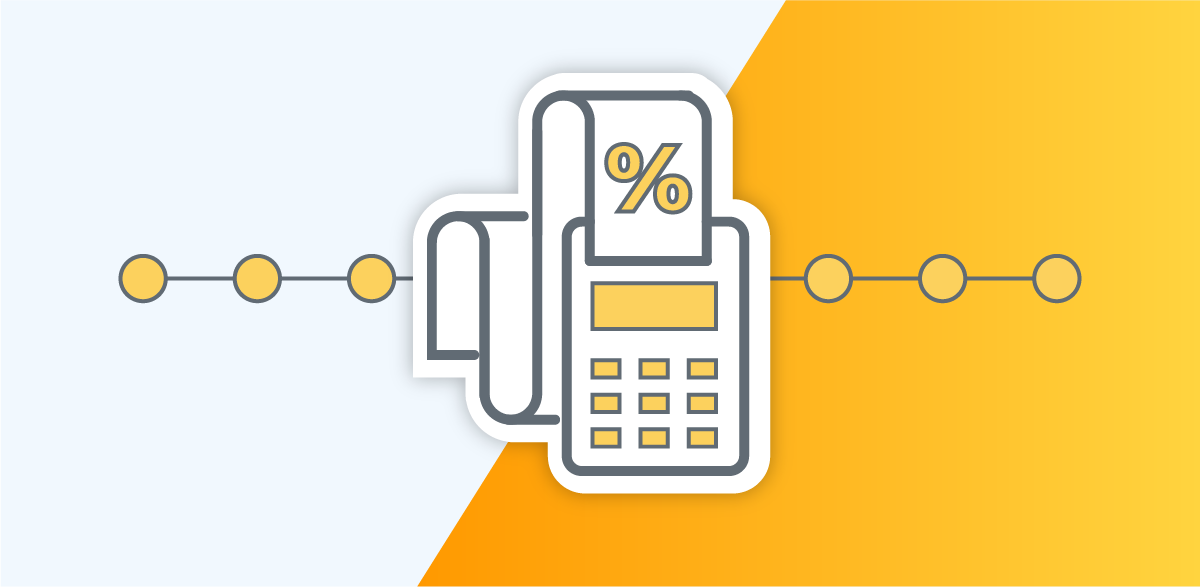
Amazon Sales Tax Guide
Robin Hanna, July 23, 2020
Table of Contents
Unless you’re an accountant, your first response to all things taxes is probably: Not today.
Alas, you can’t put it off forever, which is probably why you started researching Amazon sales tax and ended up here.
Want to know more about U.S. sales tax?
Unsure about Amazon’s responsibilities (and yours) in collecting and remitting your tax? This article will answer your questions.
From a tax perspective, selling products is particularly complicated in the U.S. While the EU-wide goods and services tax “VAT” just about takes care of itself, U.S. sales tax is not regulated on a federal level.
Instead, each of the 50 different states (and Washington D.C.) has its own legislative take on sales tax. The rules of each state branch out even finer by regional districts, local tax rates, and the type of product you sell.
The amount of tax you need to collect from your buyer and remit to the tax authority depends on where your business is located — or where your customer purchased your product. Or both. Or neither.
Confused yet?
Over the last few years, Amazon sellers have had to deal with rising vertigo from shifting sales tax laws, loopholes, and regulations.
One major relief was the legislative move to define Amazon and other online shopping platforms as “Marketplace Facilitators”.
The new laws forced Amazon to take on the responsibility of collecting and remitting sales tax for its third-party sellers on amazon.com, its U.S. marketplace.
The caveat: Not all states are covered. The administrative tax filing system hasn’t caught on yet, so there’s no section for marketplace tax in your tax report. The new tax law was passed to simplify the filing process, but it also adds a new level of complexity that sellers are unaccustomed to.
If you were among the affected sellers, you probably anticipated the next tax filing period with bewildered anxiety. Eerie tales of mid-range sellers receiving sudden tax fines of millions of dollars made the rounds and fanned the fire of uncertainty.
Thanks to most states committing to Marketplace Facilitator Laws in 2020, many of these fires have simmered down.
But the adjustments raise other questions: If Amazon started collecting and remitting on your behalf this year — do you still need to report your sales? And if so, why isn’t there a dedicated space on the tax report for that? As an FBA-seller — where is Amazon storing your goods? Maybe you need to collect and remit tax after all… How do you know?
Sales tax compliance is no laughing matter and easy to get wrong, with sometimes devastating consequences.
Here’s everything you need to know to stay sales tax compliant and protect your business from expensive surprises.
DISCLAIMER: This article was not written by a qualified tax attorney or accountant.
While the utmost care was taken to provide the correct and current information, this is not legal advice and Sellics cannot be held accountable for any actions resulting from this article. Always seek legal advice from a qualified expert.
What Is Sales Tax?
Sales tax is a tax on the sale of goods and services. As a retailer, it is up to you to collect the right amount of sales tax from your buyers and pay it back to the state.
The amount of sales tax that you need to charge depends on the legislation of the states in which you conduct your business.
Forty-five individual states and the U.S. Capitol, Washington D.C., have a sales tax (Washington D.C. is not a state, but it operates like a state for the purposes of sales tax compliance). Five U.S. states do not have a sales tax at all.
If your state requires sales tax, there are some main variances to consider:
Product taxability: First, find out if your product or service is taxable at all. Then look up its tax rate. Some states have special rates for certain products, like groceries or clothes (for example 1% tax on groceries instead of the full 6% sales tax rate).
Local taxes: Local taxes are a few percents that vary by postcode and are added to the statewide sales tax. Marketplaces often don’t consider local tax in their calculation, so you need to be aware of it.
Tax Sourcing Rules: States want you to use either the tax rate at your place of business (origin-based) or the shipping address of your buyer (destination-based).
Sales Tax Nexus: States can only require a seller to charge sales taxes if that seller has “sales tax nexus” in that state. Nexus means that your business has a significant presence in that state.
Whether or not your business has sales tax nexus plays a pivotal role in the current legal landscape and your responsibilities as a brand selling on Amazon. So let’s take a closer look.
What Is Sales Tax Nexus and Do I Have It?
You have sales tax nexus in a state if your business has a significant presence in that state. Once you establish nexus, the state will consider you liable to collect sales tax there.
If you have nexus in a state, you need to apply for a sales tax permit and collect the tax from your customers. This also applies to you if you are operating from outside the U.S.
Here are some of the factors that can establish nexus in a state:
A Physical Presence – Such as a home office, warehouse, store, or other location
Affiliates – Someone who sends customers to your online store for a percentage of the profits from a sale
Personnel – Employees, salespeople, and even some contractors can establish nexus
Drop-Shipping – A situation where you have a relationship with a supplier to ship inventory to your customers
Selling items at a trade or craft show
Inventory – Sales tax nexus usually exists if you store goods for sale in a state. As an FBA seller, you’ll generally have sales tax nexus in states that store your products for sale.
It’s the latter point — Inventory — that caused a lot of uneasiness among sellers. After all, Amazon decides where to store your FBA goods — not you. As such, you could have nexus in a state without knowing about it.
To the demise of some sellers, state tax authorities were happy to point out this ignorance with heavy fines.
Why is tax compliance so complicated?
How Amazon Sales Tax Works for Sellers — Understanding Remote Commerce and the History of Economic Nexus
Before mid-2018, sales tax was a little simpler. Authorities could only require sellers with a physical presence in a state to collect and remit tax, a longstanding rule from before the age of eCommerce.
While these were happy, uncomplicated days for online brands, the government wanted a piece of the pie.
According to the National Conference of State Legislatures, the states lost out on $17.2 billion in sales taxes in 2016 because online businesses were not being held accountable.
On June 21, 2018, the Supreme Court of the United States ruled in favor of the state in South Dakota v. Wayfair, Inc.
This milestone shift, commonly known as “The Wayfair”, removed the necessity of a physical presence and allowed states to require remote sellers to collect and remit sales tax.
From a state's point of view, any online seller who uses resources in their state (roads for delivery, public safety should an emergency occur, etc.) now has nexus.
Once sellers pass a certain threshold (typically $100k annual gross sales or 200+ transactions in the current or previous year), they must register with the tax department and collect the state sales tax as well as local and special district sales taxes.
All but two of the 45 states with sales tax (plus D.C.) were quick to establish their own set of rules for such an “economic nexus”.
Florida and Missouri are the last ones to hold out. That’s right: unless you have a physical presence of sorts in those two states, you don’t need to bother with Amazon sales tax and effectively have a tax-free sales advantage.
Expect this to change towards the end of 2020, however, as a bill in Florida is currently gaining traction and Missouri will probably follow suit.
In addition, Amazon has quite a few fulfillment centers in Florida, meaning you probably do have a physical nexus there.
As you can see, this presents somewhat of a conundrum: Thanks to the Wayfair ruling, wherever Amazon chooses to store your product, you effectively have nexus in that state.
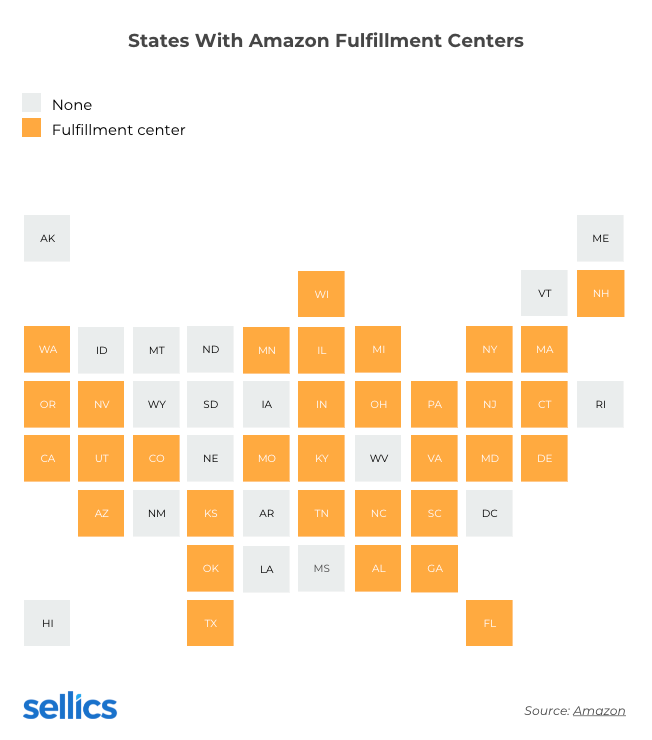
List of all the locations of Amazon warehouses
How do I know where my FBA products are stored?
Amazon FBA sellers can pull the Inventory Event Detail Report from Amazon Seller Central to determine where their inventory is stored. You can also use TaxJar — its Amazon badge feature will show you at a glance from where your items are shipping.
Amazon itself was not particularly affected by the Wayfair verdict, because the platform had been collecting sales tax for its products across the nation for years.
But the ruling left marketplace sellers — who are responsible for almost half of the sales on Amazon — in murky waters.
Some state tax authorities, most prominently the California Department of Tax and Fee Administration (CDTFA), decided that third-party sellers using FBA were conducting business in their state by storing products in fulfillment centers, and thus were responsible for collecting and remitting sales tax.
It didn't matter that FBA sellers had no control over where Amazon decided to store their products.
The CDTFA claimed that sellers failing to collect California sales tax were committing a felony which could result in fines up to $20,000 or even imprisonment.
Some sellers received notices by the CDTFA demanding taxes from the previous 8 years, racking up six-figure sums that could force small business owners into bankruptcy.
One Philadelphia-based seller received a notice from California informing him that he owed $ 1.6 Million in sales tax — for the first half of 2019.
By this time, the majority of states had already used another opportunity the Wayfair ruling offered: The Marketplace Facilitator Law.
What Is Marketplace Facilitator Law?
As recent as January 2020, California eventually joined the ranks of states that make use of Marketplace Facilitator Law, which re-defined Amazon and other platforms as “sales facilitators” and thus requires them to calculate, collect, and remit sales tax.
At the time of writing, 37 states and Washington D.C. have passed a Marketplace Facilitator Law (MFL).
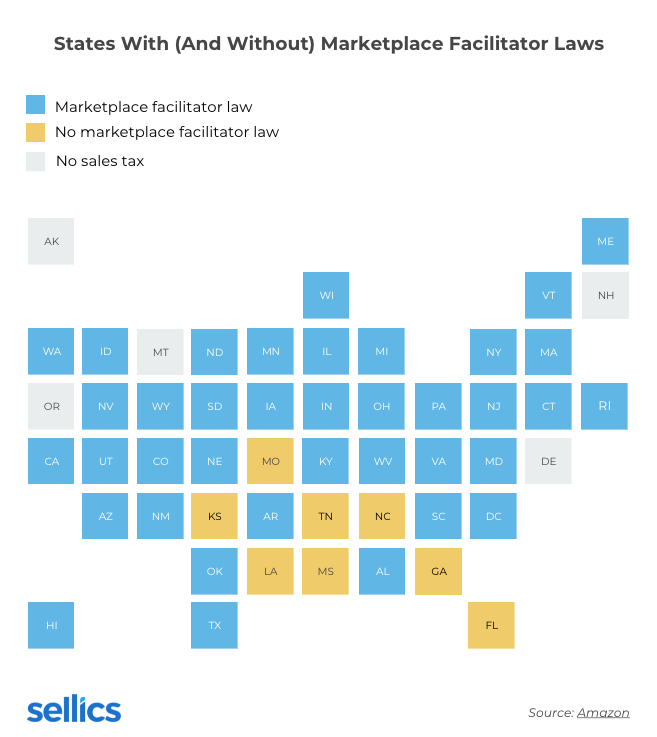
While this comes as a welcome relief for sellers (particularly with respect to California), sellers need to remember that there are eight remaining states where the standard rules of economic and physical nexus still apply.
In fact, the MFL does not remove your nexus at all.
Even when Amazon takes care of collecting and remitting sales tax, you still need to make sure you’re tax compliant, which includes:
Obtaining a tax permit in the state you are operating from (and have nexus in) and filing your tax report there
Including your Amazon sales on your report
Reporting “Zero” Amazon sales tax if the platform covered all of your transactions
Adding local tax where applicable — Some states don’t include their local taxes in MFL and you are responsible for them
Collecting and remitting sales tax for all your sales that take place or are stored in states without MFL
Understanding how to collect sales tax if you are v.s. are not based in the relevant state.
Why does it matter where you are based? The terms are “origin-based” or “destination-based” sourcing.
Amazon Sales Tax: What Is Origin-Based or Destination-Based Sourcing?
States decide if sellers should charge sales tax at the tax rate of their business location (origin-based) or, more commonly, the buyer's shipping address (destination-based).
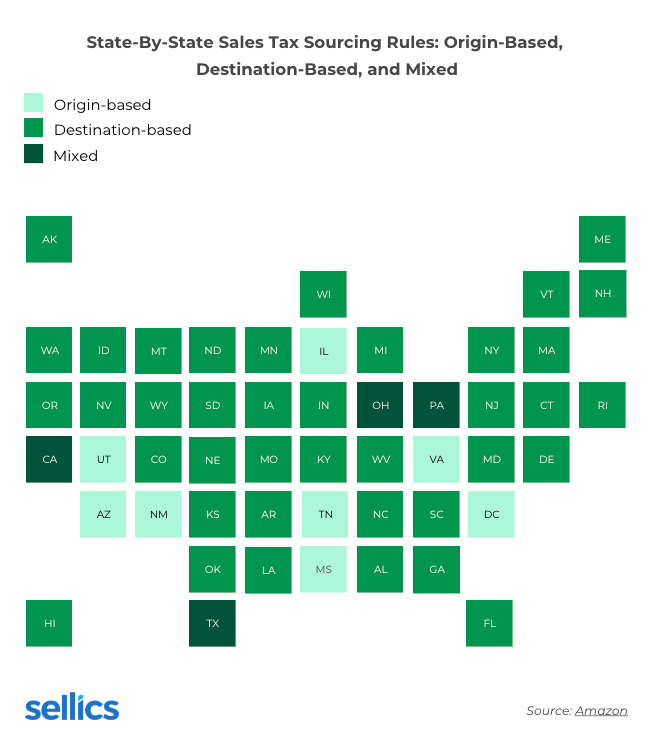
Both types of sourcing have their advantages: Origin-based sourcing supports your immediate district, while destination-based sourcing ensures that tax is evenly distributed among local areas of the jurisdiction.
The way Amazon deals with sales tax sourcing is one of the many examples why it’s such a robust tax collection engine. The ability to collect more than one sales tax rate per state is very important, and Amazon is very reliable here.
Let’s take a look at two examples of states without Marketplace Facilitator Laws:
Tennessee
Tennessee is home to multiple Amazon Fulfillment Centers, so you will have sales tax nexus if your products are stored here.
Tennessee is an origin-based sales tax state, so if you operate from here, charging tax is fairly straightforward — You collect sales tax at the tax rate where your business is located.
The statewide sales tax rate is 7%, plus local taxes between 1.5% and 2.75%, depending on where your office is located in Tennessee. So you always charge the same rate, which is somewhere between 8.5% or 9.75%.
It’s a little trickier for remote sellers. You could either charge buyers the flat 9.25% sales tax rate or the actual sales tax rate of 9.5%.
North Carolina
North Carolina, on the other hand, is a destination-based state — If you operate from here, you collect sales tax at the tax rate where your buyer is located.
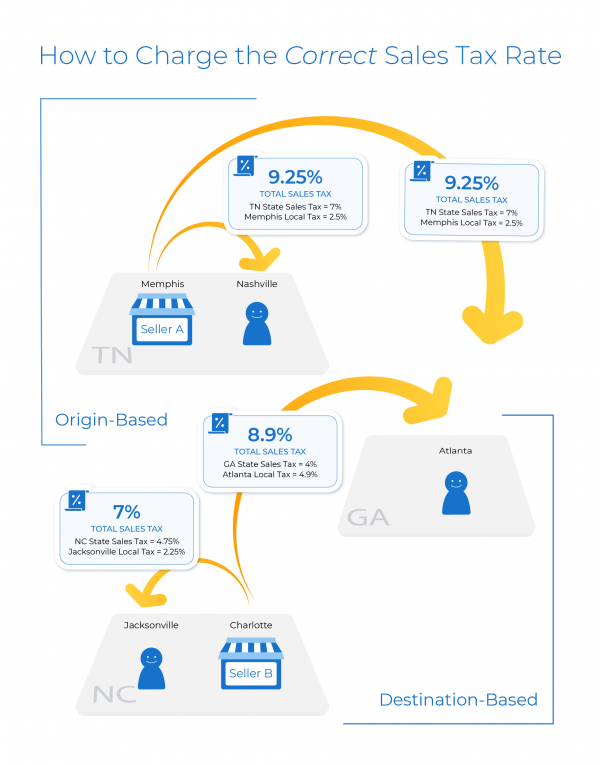
How to charge the correct Sales Tax Rate
So far, so good, but let’s mix it up a little.
What happens if you have nexus in both an origin-based and a destination-based sales tax state?
We asked TaxJar’s Jennifer Clark for help on this one.
“Let’s say you live and operate your business in North Carolina but your products are stored in a fulfillment center in Tennessee. You now have sales tax nexus in both North Carolina and Tennessee.
Tennessee is an origin-based sales tax state for in-state sellers, but in this case you are considered a “remote seller” since you are based in North Carolina.
Since you are a “remote seller,” Tennessee’s origin-state sales tax rules don’t apply to you. So if you were to make a sale to a buyer in Tennessee, you would charge that buyer sales tax based at their local sales tax rate — that is, using destination-based sales tax rules.”
To break it down:
If you live in an origin-based sales tax state, charge sales tax to same-state customers at your local area’s total combined sales tax rate.
If you are considered a “remote seller” in an origin-based state, you’ll probably be required to charge sales at the total combined sales tax rate of your customer’s location.
If you are considered a “remote seller” in a destination-based state, and have nexus in that state, you’ll probably be required to charge sales at the total combined sales tax rate of your customer’s location.
To recap:
If you are an Amazon seller conducting business from or into a state with Marketplace Facilitator Law, you do not need to collect and remit sales tax. Amazon will do it for you. You do need to include all sales on your tax report, however.
Storage of your products in a fulfillment center will usually create nexus in that state. If that state does not have a Marketplace Facilitator Law, you either collect Amazon sales tax at the rate of that state (origin-based) or at the rate of the buyer’s state (destination-based).
It is your responsibility to be tax compliant. Save yourself the time and hassle of studying Amazon’s inventory report. Let others worry about the logistical journey of your products so you can focus on your business — We recommend TaxJar, the sales tax automation system that fully integrates with your Amazon business.
Here’s the minimum you should know about your sales tax duties.
Basics of Amazon Sales Tax Compliance
Register for permit
If you have nexus in a state, you need to collect sales tax there and, therefore, need a permit to do so. Don’t collect tax without a permit — It’s illegal because everyone will think you might keep the money.
To get a permit, contact the [State] Department of Revenue, which will also tell you a sales tax filing frequency: monthly, quarterly or annually.
Collect Tax
See above.
You may ask yourself:
Does Amazon collect sales tax for sellers?
Yes, but only for products sold on Amazon. Remitting and charging sales tax for off-Amazon deals is up to you.
Report and File Tax
You need to report how much sales tax you collected in each state, city, county, and other special taxing jurisdiction in all of your nexus states.
And that's just the basic requirement — if you sell on multiple channels and have to file several sales tax reports, you probably know how difficult it is to navigate through such a dense web of information.
Chances are you already let a specialized software like TaxJar do the hard work for you. We highly recommend you give it a try, it will save you a lot of time and nerves!
Tip: You need to file a sales tax return even if you didn't collect any Amazon sales tax in that period, a so-called “zero-return”. This includes your Amazon sales in states with Marketplace Facilitator Laws, meaning you need to report “$0” in “Total {State} Sales”. MFL does not make your products non-taxable — their tax has just already been paid.
Tip 2: About half the states recognise your effort of being a tax collector and allow you to keep 1-2% of your collected sales tax. if you file and remit sales tax early or even just on time.
Tip 3: Did you know? In most cases, your sales tax permit doubles as a resale certificate/seller's permit. That means if you are buying products with the explicit aim to sell them and were charged sales tax, you can reclaim the tax you paid the next time you file your tax report.
Tools to Help You to Stay Tax Compliant on Amazon
Amazon
Amazon has a very robust sales tax collection system. You need to tell it what to collect, but once you do, it will collect the correct and up-to-date tax rate, and will process even complicated concepts like origin-based or destination-based sourcing without a problem.
You can easily charge the right amount of tax for variable items such as groceries, clothing, shipping, and gift-wrapping by adding the respective product tax code or selecting it from the drop-down menu.
New search and filter options to help you identify the states you calculate tax for and or view only the ones Amazon calculates tax for.
To set up the sales tax system in Seller Central, go to Settings — > Tax Settings.

For Sellics to display tax in your profit dashboard, you need to enable this Amazon tax calculation.
While this setup is useful to track your sales and charge the correct amount of tax each time, you still need to consolidate your information to file your tax report and, when necessary, remit the sales tax Amazon collected for you.
What states does Amazon charge sales tax in?
Amazon collects sales tax nationwide, in all states with sales tax (and D.C.), but will only remit in a state with Marketplace Facilitator Law.
View your Amazon Order Breakdown to see how much tax Amazon is charging your customers: Go to Orders → Order Reports.
To see where Seller Central holds all the documentation you need for remittance: Go to Reports → Tax Document Library.
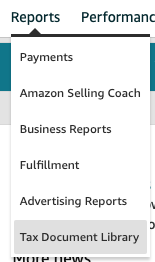
The Inventory Event Detail Report shows you in which states your products were stored and, therefore, created nexus: Go to Inventory → Inventory Reports.
Tax On, Tax Off — How Sellics Deals With Amazon Sales Tax
Sellics purely deals with your actionable costs and profit. Since sales tax is a “pass-through” value, i.e. doesn’t reflect the health of your business, the figures you see in Sellics are net values and don’t contain sales tax.
The Amazon API delivers data on marketplace facilitator tax, however, which currently still shows up in the Sellics profit dashboard as a summed income value. As a workaround, we add the same value as a cost, so that the total equals zero.
For example: A shopper buys your product for $5. Amazon deducts $0.35 tax, so you get $4.65. In the Sellics profit dashboard, it's shown as $5 income and $0.35 Cost (tax).
It can be confusing, because you never in reality receive the full $5, but at the moment it's the only workaround we have. We are working on a solution for this and will probably remove the display of Amazon sales tax altogether.
Sellics will help you to maximise the efficiency of your Amazon business — let others take care of the pains of tax compliance.
That’s why we warmly recommend using TaxJar together with Sellics. With this powerful combination, you can forget about your taxes and use Sellics to accelerate your growth on Amazon.
And that’s it — now you know everything there is to know about sales tax.
Only joking! This topic is so vast and variable, we couldn’t possibly go that far. Please also keep in mind that none of this is legal advice and you should always refer to a professional expert.
But now you understand what Amazon sales tax is and the mechanics of how it affects your business. These rules apply to you, whether you are operating from inside the U.S. or just selling there.
The greatest value of this knowledge is to gain peace of mind. Use it to adjust your tax record or Amazon tax settings, or simply to rest assured that you’ve been tax compliant all along.
Even better: With TaxJar you can forget all about your Amazon sales tax, and invest that time to optimize your Amazon campaigns with the Sellics PPC manager! Or, you know, play with your kids or catch a movie.
Which of the above rules have affected your business? What has changed for you since the introduction of Marketplace Facilitator Law? Let us know in the comments!
To get started or learn more about how Perpetua can help you scale your Amazon Advertising business, contact us at hello@perpetua.io